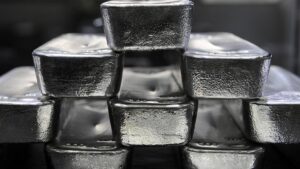Monsters of Rock: While you were looking at BHP, this iron ore miner hit the sweet spot

Pic: Syed Farhan Hussain/Moment via Getty Images
-
- Mount Gibson Iron delivers a standout quarter, hitting record high grade iron ore shipments for December half at Koolan Island
- Ora Banda, Alumina among producers reporting
- Jarden knocks down Liontown price target, but Albemarle share sale has already knocked the lithium developer down a peg
Mount Gibson Iron (ASX:MGX), the long term iron ore stock which effectively missed the 2021 boom in iron ore prices, has been rewarded for staying the course.
MGX is the owner of the Koolan Island mine in WA’s far north, one of a handful of hematite deposits worldwide high enough in quality to ship a grade in excess of 65% Fe.
The traditional benchmark is 62% Fe, around the grade of Rio Tinto’s (ASX:RIO) Pilbara Blend Fines, the mainstay of the seaborne iron ore trade.
And nowadays the big boys extract grades lower than that, with lower grade fines and lump products and increasing part of the sales mix of their ageing Pilbara operations.
That means MGX pulls in strong premiums, which can deliver good cash margins even though its production rate is modest.
In the first half of the financial year, MGX sold a record 2.5Mwmt including 1.2Mt at an average grade of 65.3% Fe in the December quarter.
That translated to $123 million in cash flow, with cash operating costs of $62/wmt on each tonne sold generating a margin of $108/wmt.
FOB operating costs of the half year of $59/wmt came in below guidance, with MGX plotting to sell some 3.8-4.2Mwmt of high grade ore at $65-70/wmt FOB.
Not bad at all. Mount Gibson boosted its cash on hand including share and option holdings in Fenix Resources (ASX:FEX), which purchased its unloved Mid West assets last year, to $358m, up from $257m at the end of September.
The Platts 65% Fe iron ore price rose from US$111/t in the December quarter of 2022 to US$139/t by December 2023, with MGX pulling in an average of US$128/t in the last three months and US$116/t on average over the totality of 2023.
“Mount Gibson delivered a strong operating and financial performance in the December quarter and for the first half of the 2023/24 financial year. The Koolan Island mine generated significant positive cashflow from high-grade ore production, underpinning
the growth of the Company’s cash and investment reserves,” MGX CEO Peter Kerr said.
“Consistent with guidance, fifteen shipments were completed totalling 1.2 Mwmt in the quarter, resulting in record six monthly high-grade ore sales from Koolan Island of over 2.5 Mwmt.
“We expect sales to moderate during the northern Western Australian wet season and into 2024 now that ore stockpiles have reverted to normal levels but with iron ore prices remaining well supported, Mount Gibson is in a strong position to achieve its FY24 annual guidance of 3.8-4.2 Mwmt and to increase its capacity for new investment opportunities.”
MGX has around three years of mine life left at Koolan Island to build a warchest, with the firm saying it its targeting opportunities in bulk commodities and base metals with a focus on Australia.
MGX shares rose 3.4% on the quarterly despite dour conditions for iron ore miners in the broader market as lower Chinese stimulus hopes sent Singapore prices down slightly to US$125.45/t.
Mount Gibson Iron (ASX:MGX) share price today
Ora Banda lifts gold output, Liontown falls as focus goes onto Kathleen Valley
While the impacts of battery metals prices on BHP and Albemarle’s WA nickel and lithium operations are the big focus in the Aussie resources market today, there’s plenty of news flying around the large and mid cap mining space as investors return from their New Years siestas.
WA1 Resources (ASX:WA1) has returned to market with another $40 million raised at $10 a share to continue drilling at its P2 and Luni niobium discoveries in WA, where an initial resource estimate is due in the June quarter.
Alumina (ASX:AWC) released its quarter results, revealing a lift in margin for the Alcoa alumina business the ASX stock boasts a 40% stake in from $53m in the September quarter to $84m in the December quarter on easing caustic soda prices.
Cash costs have fallen from US$329/t in the June quarter and US$303/t in the September quarter to US$291/t in the December term, with costs outside of the San Ciprian and Kwinana refineries, the latter of which Alcoa plans to shutter in the coming months, coming in at US$263/t.
That compare to API alumina prices of US$370/t yesterday.
Meanwhile, recovering gold miner Ora Banda Mining (ASX:OBM), up 132% in the past 12 months, said it saw a 15% increase in gold sales from its Davyhurst plant near Kalgoorlie to 15,837oz in the December quarter.
All in sustaining costs at Davyhurst fell 15% to $2499/oz and $2157/oz in November and December, with processing of material from the new Riverina underground deposit due to begin this month.
MD Luke Creagh said the December quarter, which also included a $10m sale of lithium rights in a JV with Wesfarmers (and $20m on the way on the deal’s completion), was a ‘key transition period’.
He added that a large exploration program had begun at the Sand King deposit, which could become a second underground option.
This is all a work in process still though. OBM finished the quarter with $19.24m in cash, down from $22.73m at September 30 after spending $16.8m on growth capex including $11.1m on the Riverina development in the three months to December 31.
OBM was up 1.1% at 3.30pm AEDT.
Going the other way was Liontown Resources (ASX:LTR), down 11.8% to $1.20. The Kathleen Valley lithium mine developer was trading upwards of $3 when a bid at that price, killed by an interloping Gina Rinehart, was in play from Albemarle last year.
But Albemarle sold its 4% stake at a discount this week, sending Albemarle’s shares falling even further.
It’s now trading close to the $1.19 valuation ascribed to the stock in a note today from Jarden analysts Jon Bishop and Ben Lyons, who have a sell rating on the developer after the dramatic fall in lithium prices which has shrouded the sector.
Of that a NAV of $2.4b on Kathleen Valley makes up the bulk of the value — around $1 a share.
With 6% Li2O spodumene prices currently around US$900/t — well below Jarden’s long term forecast of US$1400/t — the most recent numbers from LTR anticipated costs of $651/t (US$423/t) excluding royalties.
They say there appears to be sufficient liquidity at Liontown to get the company through to commercial production, but cautioned Liontown’s recoveries (78% for a 6% Li2O concentrate) would be “industry leading by some margin”.
“Overlaying that current prices are starting to ‘eat into’ the hard rock cost curve, we are comfortable in our forecast for a recovery in pricing over the medium to long term, so we view it reasonable at this stage to highlight the robustness of LTR’s balance sheet should its process flowsheet and underground operations achieve design specifications but reflecting that 78% recoveries delivering 6% concentrate would be industry leading by some margin,” they said.
“Yet we retain our Sell rating. We cut our 12m target price in line with our $1.19/share valuation after incorporating lower short-term commodity prices, risk adjusting our downstream optionality valuation and changing our WACC assumptions.
“Taking at face value that c90% of LTR’s contracts are locked away, material pre-production capex escalation risk seems low but we view opex rises as a key risk,” they added. “We see diminished corporate appeal due to Hancock’s holding. Lithium price reversal is the key short-term risk to our rating.”
Liontown’s fall came the same day as Leo Lithium (ASX:LLL) released a truncated December quarter report which said its Goulamina mine in Mali is now 60% complete, but where it continues to be suspended from trade amid uncertainties around relations with the Malian Government.
READ: Ride the Cycles: Where does your favourite ASX lithium project sit on the cost curve?
December reporters (and Liontown) prices today

UNLOCK INSIGHTS
Discover the untold stories of emerging ASX stocks.
Daily news and expert analysis, it's free to subscribe.
By proceeding, you confirm you understand that we handle personal information in accordance with our Privacy Policy.








